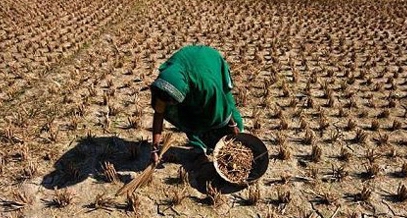
While China is burdened with 21 percent of the world's population to feed, the country contains only 6 percent of the world's total water resources and about 9 percent of its arable land, according to the report, "Food Losses and Waste in China and Their Implication for Water and Land," published in the American Chemical Society's journal Environmental Science & Technology.
Of the 19 percent total grainslost in harvest, storage, transport, processing, rotting because of bad storage or wasted, researchers found consumer waste accounted for 7 percent.
Apart from grains, the researchers estimated that about 20 percent to 30 percent of fruits and vegetables, 5 percent to 15 percent of eggs and 3 percent to 15 percent of meat are also wasted in China according to the report issued last month.
It was compiled by a team of experts including Junguo Liu of the College of Nature Conservation at Beijing Forestry University, and Jan Lundqvist, Josh Weinberg and Josephine Gustafsson of the Stockholm International Water Institute in Sweden.
The overall loss of grains used an estimated 177 billion cubic yards of water to produce uneaten food, a volume equal to the amount of water Canadian farmers use to grow all their crops, according to the report. Moreover, 64 million acres of cropland in China were sown and harvested in vain, the report said.
About $32 billion worth of food is thrown away annually in China, according to Ren Zhengxiao, head of the Chinese State Administration of Grain. The administration also reported one-third of China's grain-storage capacity is old and in bad condition. Ren told Xinhua News Agency in February that improving the quality of grain stocks and reducing food waste are as important to China as protecting its arable land.
The researchers behind the "Food Losses and Waste in China" report sought to document China's loss and waste of food to assist in the development of policies that could help sustain future food supplies.
Recommendations from the report include improving storage systems, as well as raising public awareness, mechanizing the harvest of grains and putting in place monitoring programs to track food waste more efficiently.
Reducing food waste in China is already underway. In January, Chinese President Xi Jinping launched the "Clean Your Plate" initiative to reduce food waste, with a focus on zero waste in restaurants and encouraging diners to order less and take leftovers home.
The initiative has also targeted government officials who throw lavish banquets which accounted for more than $48 billion in 2012, according to the Public Radio International report. Since the initiative, catering sales have dropped as much as 35 percent in Shanghai and Beijing, the report said.
The amount of food Chinese college undergraduates waste could feed 10 million people annually, according to a report published by the Chinese People's Political Consultative Conference (CPPCC) in Beijing. In China, students typically don't have refrigerators or microwaves in their rooms, and more than one-third of college campus cafeteria food is wasted, the report said.
Food waste is not only pandemic in China, researchers behind the "Food Losses and Waste in China" report said. Globally, between one-third and one-half of food produced worldwide is lost or wasted from farm to fork, according to the report.







